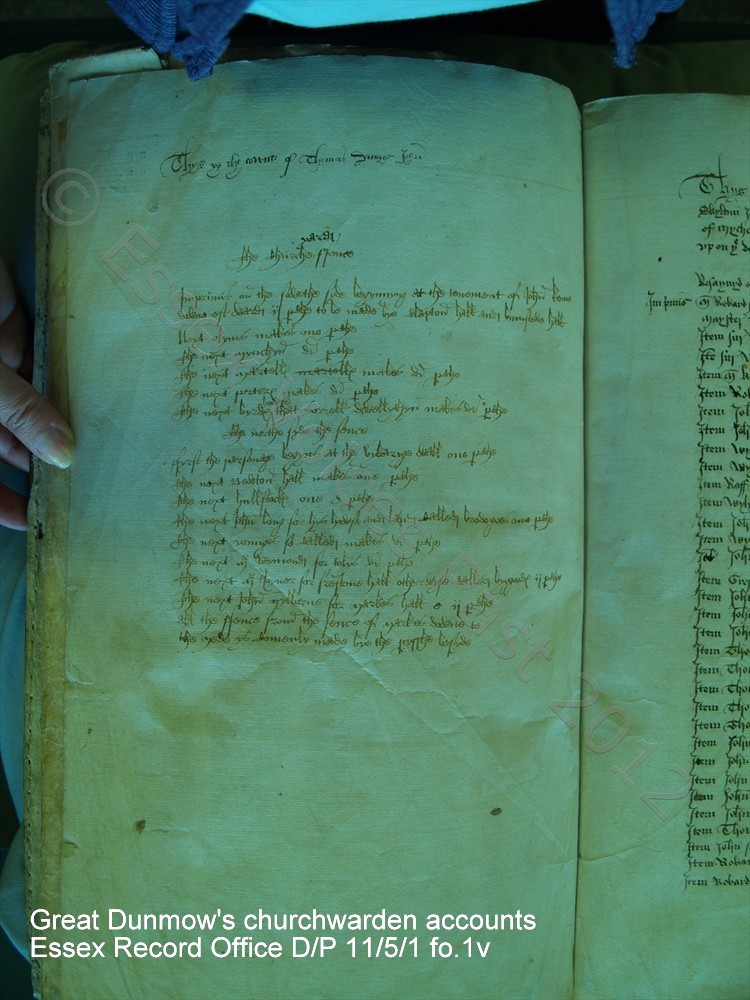Transcript fo.1v: Great Dunmow’s local history – medieval manors
Transcription of Tudor Great Dunmow’s churchwardens’ accounts
(late 1520s)
1. Thys ye the cownte of Thomas Savage John
[large gap]
2. The churche \yard/ Fence
3. Imprimis on the sowthe syde begynnyng at the tenement of John keme
4. downe est ward ij p[er]che to be made bye clapton hall and bumstede hall
5. Next olyves makes one p[er]che
6. the next mynchyn dit[to] p[er]che
7. the next martelle motrelle makes dit[to] p[er]che
8. the next portery makes dit[to] p[er]che
9. the next byrde \howse/ that Garrett dwellythyed makes dit[to] p[er]che
10. the northe syde the fence
11. Fyrst the parsonage begyns at the vykaryge wall one p[er]che
12. the next Newton hall makes one p[er]che
13. the next lynllsaw one a p[er]che
14. the next John long for hys hawse and land called brodegoes one p[er]che
15. the next younges so called makes dit[to] p[er]che
16. the next Mr Raymond for ?olys dit[to] p[er]che
17. the next Mr Joyner for frestone hall otherwyse called byggood ij p[er]che
18. the next John mylbarne for markes hall & ij p[er]che
19. all the Fence from the fence of marke downe to
20. the mede ys comonly made bye the p[ar]ysshe besyde
Commentary
The first line of this folio is the start of a heading for the churchwardens’ yearly return. The rest of the page (in a different handwriting) appears to have been written at a later date and is a list of some of Great Dunmow’s manors. This was possibly written in 1528-9 around the same time that there was a collection within the parish church for a church fence. However, the handwriting on this folio is not the same as handwriting on the page where the collection for the fence is detailed (fo.7r). The names of the men written on this folio can be cross-referenced to other entries in the churchwarden accounts to date this folio to the late 1520s.
The medieval manors mentioned on this folio were:
Line 4: Clopton Hall (also known as Southall)
Line 5: Olaves (also known as Shingle Hall, in modern times known as Olives)
Line 6: Minchins
Line 7: Martels (also known as Martins)
Line 12: Newton Hall
Line 17: Bigods (also known as Alfrestons)
Line 18: Merks Hall
(Two of Great Dunmow’s other medieval manors were not mentioned in this list – the manors of Great Dunmow and Little Garnetts)
Today the majority of the original medieval buildings have long since gone but the legacy of Great Dunmow’s medieval heritage remain within the names of farms, roads and areas of Great Dunmow. The manor-house of Newton Hall was rebuilt in the nineteenth century but the majority of its land is now taken up by the sprawl of the local Helena Romanes secondary school. Merks Hall has been rebuilt in recent years and is now the home of today’s new generation of wealthy landowners – popstars; The Prodigy’s Liam Howlett and his wife Natalie Appleton of All Saints are its current incumbents.
Terminology
perch: a unit of measure used for measuring length, area and volume
imprimis: (line 3) ‘In the first place’. Used at the start of a list of items.
Notes about Great Dunmow’s churchwarden accounts
Great Dunmow’s original churchwardens’ accounts (1526-1621) are kept in Essex Record Office (E.R.O.), Chelmsford, Essex, D/P 11/5/1. All digital images of the accounts within this blog appear by courtesy of Essex Record Office and may not be reproduced. Examining these records from this Essex parish gives the modern reader a remarkable view into the lives and times of some of Henry VIII’s subjects and provides an interpretation into the local history of Tudor Great Dunmow.
*-*-*-*-*-*-*-*-*-*-*-*-*-*-*-*-*
This blog
If you want to read more from my blog, please do subscribe either by using the Subscribe via Email button top right of my blog, or the button at the very bottom. If you’ve enjoyed reading this post, then please do Like it with the Facebook button and/or leave a comment below.
Thank you for reading this post.
You may also be interested in the following
– Index to each folio in Great Dunmow’s churchwardens’ accounts
– Great Dunmow’s Churchwardens’ accounts: transcripts 1526-1621
– Tudor local history
– Great Dunmow’s Medieval manors
© Essex Voices Past 2012-2013.

